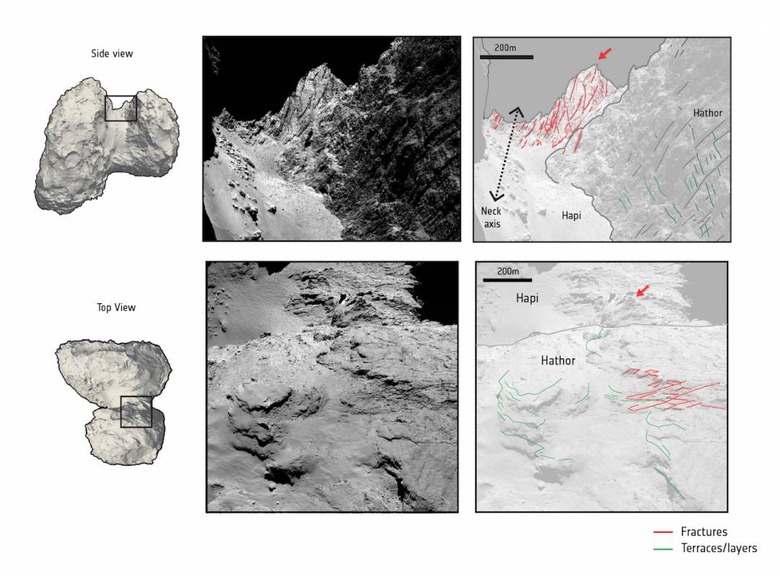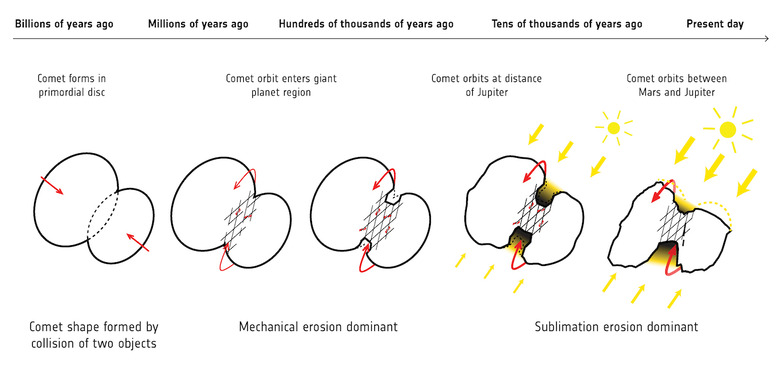This Stressed Asteroid Could Put A New Spin On NASA's Comet Blasting Plan
Groundbreaking analysis of a distant, fast-moving comet has revealed new details in how asteroids form, shedding light on the formation of unusual shapes and, potentially, paving the way for more effective protection of the Earth from meteor impacts. The asteroid, Comet 67P/Churyumov–Gerasimenko, is around 2.7 miles across and moving at as much as 84,000 miles per hour, but scientists have long been fascinated by its unusual shape.
The vaguely dumbbell-like form, with two distinct lobes joined by a central portion, helped make 67P/C-G the target of the European Space Agency's Rosetta mission. That dropped the Philae lander onto the asteroid in November 2014, where – despite a botched touchdown that saw experimentation end prematurely – it sent back valuable details about the chemical makeup.
Now, using data from Rosetta's OSIRIS camera – the Optical, Spectroscopic, and Infrared Remote Imaging System that tracks visible, near infrared, and near ultraviolet wavelengths – the ESA has pieced together a map of the faults and fractures that riddle the comet. Using stress modeling and 3D analysis, insight into how various forces shaped the rock and ice has been unlocked.

"These geological features were created by shear stress, a mechanical force often seen at play in earthquakes or glaciers on Earth and other terrestrial planets, when two bodies or blocks push and move along one another in different directions," Christophe Matonti of Aix-Marseille University, France, lead author of the research, said of the findings. "This is hugely exciting: it reveals much about the comet's shape, internal structure, and how it has changed and evolved over time."
The unusual shape is, they theorize, down to the two lobes trying to move in different directions, producing strong sheer forces in the "neck" in-between them. "It's as if the material in each hemisphere is pulling and moving apart, contorting the middle part – the neck – and thinning it via the resulting mechanical erosion," co-author Olivier Groussin explains.
Key, none of what the research has discovered could be explained by thermal processes. Instead, it could suggest that the interior of 67P/C-G is far more brittle than initially believed. A similar shape was observed more recently during the flyby of Ultima Thule, with the NASA New Horizons probe beaming back images of the twin-lobed object.

According to the scientists, insights into how comet shapes form over time could be crucial to understanding how the broader universe has evolved. "We've only explored a handful of comets with spacecraft, and 67P is by far the one we've seen in most detail," Matt Taylor, Rosetta Project Scientist at the ESA, said of the findings. "Rosetta is revealing so much about these mysterious icy visitors and with the latest result we can study the outer edges and earliest days of the Solar System in a way we've never been able to do before."
The findings could have more destructive implications, however. NASA has been working on a project know as the Double Asteroid Redirect Test, or DART, for several years now. Its goal is to figure out a way for an asteroid on a potentially dangerous course toward Earth to be shifted on its course, or possibly even destroyed altogether.
To do that, DART will use a so-called "kinetic impactor technique": basically smashing one object into another. The project plans to launch a probe in 2022 that will reach Didymos B, an asteroid roughly 530 feet across that is expected to come relatively close to Earth in late 2022 and then again in 2024. When sufficiently close, the DART probe – which is about the size of a refrigerator – will lock onto the asteroid and then accelerate into it.
When it hits, the space agencies say, it should be traveling at approximately 3.7 miles per second. That's around nine times faster than the speed of a bullet. Even then, it's a tiny fraction of Didymos B's overall velocity. The theory behind DART is that a small change, applied sufficiently early to a potentially hazardous asteroid, would be enough to move its course in a significant way once it came nearer to Earth.
Better understanding the internal geometry and composition of asteroids with techniques as applied to 67P could well shape future methods used by planetary defense projects such as DART. After all, if a space rock is riddled with erosion and stress cracks, it might take less energy from a DART collision to deliver that all-important shift in trajectory. Alternatively, it could allow asteroids spotted later to still be moved, because a DART probe could have a larger than predicted effect upon impact.
